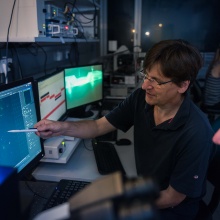In the past decade, biological nanometer-scale pores (ion channels) were explored as the basis for technologies to analyze single molecules in aqueous solution. The channels were used as a Coulter Counter, where macromolecules carrying a net electrical charge were driven through a trans-membrane channel by an electric field. Macromolecules entering the pores produced measurable drops in the ionic current. Typical current drops were in the range of 100 pA at electric fields of ca. 107 V/m. The Coulter method provided sufficient force to transfer molecules through the pore. Possible applications were the analysis of transport process of biomolecules through confined spaces and the determination of macromolecule concentrations in small volumes. The distictive feature making the nanopores useful was that the scale of the pores was the same as that of the molecules.
Pioneering work in this field started with electrophysiological experiments on single biological alpha-hemolysin channels addressing the question whether single stranded DNA molecules can be transferred through alpha-hemolysin pores. Based on these studies, a variety of modifications were introduced into the alpha-hemolysin structure to achieve discrimination between single-nucleotides moving through the pore. Within the Competence Network on Functional Nanostructures of the Baden-Württemberg Foundation and as part of the research iniative Clusters4Future nanodiag BW of the Federal Ministry of Education and Research (BMBF) we are working in a joint project with Prof. Jan Behrends (Freiburg) on the design of novel membrane-chips for biosensing.
Selected Publications:
- Morphology remodeling and membrane channel formation in synthetic cells via reconfigurable DNA nanorafts. Fan, S., Wang, S., Ding, L.J., Speck, T., Yan, H., Nussberger, S. & Liu, N. Nature Materials 24: 278-286 (2025)
- 3D DNA origami pincers that multitask on giant unilamellar vesicles. Zhan, P., Yang, J., Ding, L., Jing, X., Hipp, K., Nussberger, S., Yan, H. & Liu, N. Science Advances 10: 1-7, eadn8903 (2024)
- Tracking the activity and position of mitochondrial β-barrel proteins. Wang, S. & Nussberger, S. Methods Mol. Biol. 2778: 221-236 (2024) (Journal cover)
- Wang, S. & Nussberger, S. Single-molecule imaging of lateral mobility and ion channel activity in lipid bilayers using total internal reflection fluorescence (TIRF) microscopy. J. Vis. Exp. (JoVE) 192: 1-21, e64970 (2023)
- Wang, S., Findeisen, L., Leptihn, S., Wallace, M.I., Hörning, M. & Nussberger, S. Spatiotemporal stop-and-go dynamics of the mitochondrial TOM core complex correlates with three-state channel activity. Communications Biology 5: 471 1-11 (2022)
- Bieligmeyer, M., Artukovic, F., Nussberger, S, Hirth, T., Schiestel, T. & Müller, M. Reconstitution of OmpF into biomimetic block copolymer-phospholipid hybrid membranes. Beilstein J. Nanotech. 7: 881–892 (2016)
- Gessmann, D., Mager, F., Naveed, H., Arnold, T., Weirich, S., Linke, D., Liang, J., & Nussberger, S. Improving the resistance of a eukaryotic beta-barrel protein to thermal and chemical perturbations. J. Mol. Biol., 413:150-161 (2011)
- Romero-Ruiz, M., Mahendran, K.R., Eckert, R., Winterhalter, M., & Nussberger, S. Interactions of mitochondrial presequence peptides with the mitochondrial outer membrane preprotein translocase TOM. Biophys. J., 99: 774-81 (2010)
- Arnold, T., Poynor, M., Nussberger, S., Lupas, A.N.,& Linke, D. Gene duplication of the eight-stranded beta-barrel protein OmpX produces a functional pore: A scenario for the evolution of transmembrane beta-barrels. J. Mol. Biol. 336, 117-1184 (2007)



